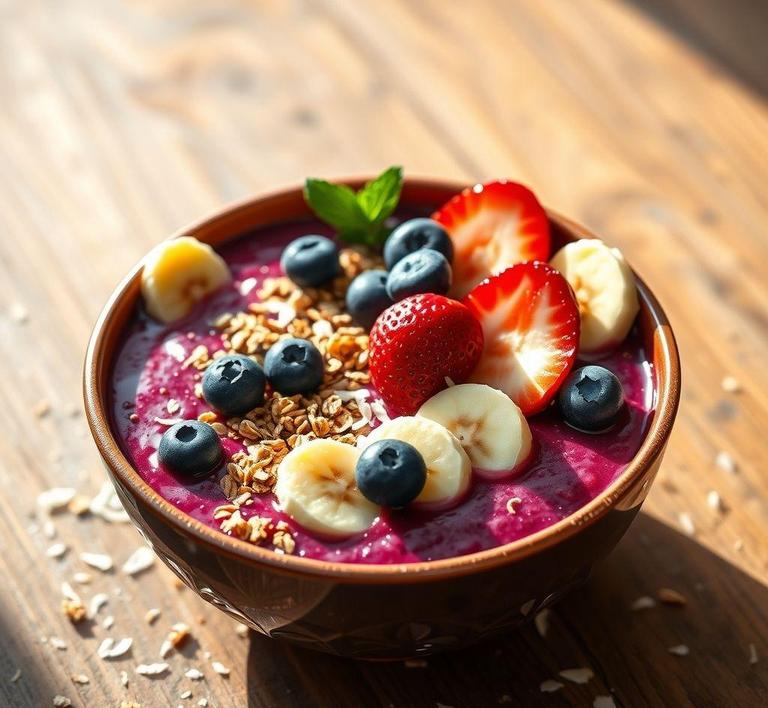If you’re someone who loves acai bowls but has leftovers that you don’t want to waste, learning how to refreeze an acai bowl can be a game changer! Whether you made too much or you just want to preserve that delicious flavor for later, refreezing an acai bowl is totally doable. But, there are a few things to keep in mind to ensure the texture and taste stay top-notch when you thaw it out again. From choosing the right container to knowing when it’s time to toss the bowl if it’s been too long, this guide will walk you through everything you need to know to keep your acai bowl fresh and tasty for the long haul!
Can You Refreeze Acai Bowl?

Acai bowls have become a popular choice for breakfast, snacks, and even desserts due to their vibrant colors, refreshing taste, and numerous health benefits. They’re made from acai berries-native to the Amazon rainforest-blended with other fruits and a variety of toppings like granola, coconut flakes, nuts, seeds, and honey. But, as with most perishable foods, sometimes leftovers happen, and the question arises: Can you refreeze an acai bowl?
The short answer is yes, you can refreeze an acai bowl, but with several important considerations. Refreezing an acai bowl is not as straightforward as simply placing it back in the freezer. Freezing and refreezing can impact both its texture and taste. However, if done properly, you can preserve its taste and nutritional value for a little longer.
How To Refreeze Acai Bowl?
Refreezing an acai bowl requires some careful handling to avoid compromising its quality. Here are step-by-step instructions on how to do it:
-
Assess the Ingredients:
The key to a successful refreeze is understanding that not all ingredients in an acai bowl freeze and thaw the same way. The acai base, usually made from pureed acai berries, generally freezes well. However, certain toppings-like fruits, granola, or yogurt-may not fare as well when refrozen, as their texture could change, becoming soggy or mushy.
-
Separate Toppings:
If possible, it’s best to remove or separate toppings like granola, fresh fruit, or yogurt before freezing. These ingredients are delicate and may lose their crispness or freshness when frozen and thawed. Granola, for instance, tends to become soggy after freezing. Fresh fruits can become mushy upon thawing. Store them in airtight containers separately and add them back after the acai bowl has been refrozen and thawed.
-
Wrap the Bowl Properly:
Once the toppings are removed, wrap the acai bowl tightly in plastic wrap or store it in an airtight container. This is critical to avoid freezer burn. If air gets in, it could degrade the quality of the acai base and affect the flavor.
-
Label and Date:
It’s always helpful to label the container with the date so you know how long the acai bowl has been stored in the freezer. Typically, frozen acai bowls should be consumed within 2-3 weeks for optimal quality.
-
Freezing Process:
Place the bowl in the coldest part of your freezer. Ensure the temperature is stable, ideally around 0°F (-18°C), to prevent any bacteria from growing.
-
Thawing Process:
When you’re ready to eat the refrozen acai bowl, don’t simply leave it out at room temperature for too long. The safest method is to transfer it from the freezer to the fridge and let it thaw gradually overnight. This prevents condensation from forming, which could lead to a soggy bowl. If you’re in a hurry, you can thaw it on the counter for about 30 minutes, but keep an eye on it to ensure it doesn’t get too warm.
-
Add Fresh Toppings:
Once the acai bowl has thawed, feel free to add back the toppings that you stored separately. Fresh fruits, granola, or other toppings can help restore the texture and flavor that might have been lost during the freezing process.
Quality Impact
While refreezing an acai bowl is possible, it’s important to understand the potential quality changes that may occur. Freezing and thawing cause water molecules in the food to expand and contract, which can change the texture and flavor of the ingredients. Below are the primary factors to consider when it comes to quality:
- Texture Changes: Freezing acai bowls, especially with the added fruit or yogurt, can cause changes in texture. When thawed, the once-smooth acai base might become a little watery or grainy, and the frozen fruits may lose their firmness, turning mushy. Granola or any crunchy toppings will likely become soggy upon thawing.
- Flavor Alteration: Freezing might dull the vibrant flavor of acai. Fresh acai bowls tend to have a crisp, refreshing taste, but after being frozen and thawed, they may lose some of their intensity, becoming less flavorful. Additionally, if you refreeze acai bowls that have been sitting in the fridge for too long before freezing, they might also taste a little stale.
- Nutrient Loss: While freezing can preserve the nutritional value of acai bowls to some extent, repeated freezing and thawing can lead to slight nutrient degradation. For example, vitamin C is particularly sensitive to freezing, and some of the antioxidants found in acai may break down with extended exposure to the cold. However, the impact on most essential nutrients is minimal if done properly.
- Moisture Loss or Freezer Burn: Improperly wrapped or stored acai bowls can develop freezer burn, which occurs when air reaches the surface of the food and causes dehydration. This not only affects the texture but can also result in a less appetizing flavor.
Refreezing an acai bowl is possible, but it comes with some trade-offs in terms of texture and flavor. If you must refreeze an acai bowl, it’s best to remove the toppings, wrap the base tightly, and store it properly in an airtight container. Thawing the bowl slowly in the fridge can help mitigate some texture issues, but you should be prepared for some changes in the overall quality. While not ideal for frequent freezing and thawing, refreezing acai bowls in a pinch can help reduce waste and preserve leftovers. Just keep in mind that the fresher the bowl, the better it will taste!
Is It Safe To Refreeze Acai Bowl?
Acai bowls have become a popular, nutritious snack or breakfast item, packed with antioxidants, vitamins, and minerals. They often consist of acai puree, topped with fruits, granola, nuts, seeds, and sweeteners. While these bowls are typically consumed fresh, there are situations where you might wonder if it’s safe to refreeze an acai bowl after it’s been thawed.
In general, refreezing an acai bowl is not recommended. While it may be technically possible, doing so compromises both its texture and flavor. Acai bowls are made with ingredients that are sensitive to temperature fluctuations, especially fruits, and toppings like granola or nuts, which are prone to losing their crunchiness after freezing and thawing.
Freezing and thawing multiple times can lead to changes in the molecular structure of the ingredients. This process can cause cellular breakdown in fruits like bananas or berries, turning them mushy and watery when refrozen. The acai itself, which is rich in antioxidants and beneficial compounds, may also lose some of its nutritional value with each freeze-thaw cycle.
Signs That Acai Bowl Should Not Be Refrozen
If you find yourself considering whether to refreeze an acai bowl, it’s essential to look for certain signs that indicate it’s no longer safe or appetizing to do so. Here are some red flags to watch for:
- Texture Changes: If your acai bowl has become watery or mushy after being thawed, refreezing it will only worsen these issues. The freezing process ruptures the cell walls of fruits, and once thawed, the texture can change dramatically. Refreezing these altered ingredients can make them unappealing, often turning the once-creamy acai base into a slushy, icy mixture.
- Separation of Ingredients: When an acai bowl is left to thaw, the layers of ingredients may start to separate, particularly the liquids from the solid toppings. If you notice this happening, the components will not recombine well after refreezing, leading to uneven texture and consistency when you try to consume it later.
- Off Smell: Any sour or rancid smell should be a warning sign that the bowl has been exposed to air for too long and has begun to degrade. Acai and other fresh ingredients like bananas or berries can spoil quickly when not stored properly. If there’s any off-putting smell after thawing, discard it rather than risk refreezing it.
- Color Changes: Acai bowls can turn brown or lose their vibrant purple hue after exposure to air and light. If you notice any discoloration, it may indicate that oxidation has occurred. While this doesn’t necessarily mean the food is unsafe to eat, the quality and flavor may be compromised, making it less ideal for refreezing.
- Mold or Signs of Spoilage: This is a clear indication that the acai bowl should never be refrozen. If you spot any mold or unusual growth on the surface or around the toppings, it’s time to dispose of the bowl. Mold can grow in moist environments, which are common in thawed acai bowls.
Common Refreezing Mistakes
When it comes to freezing and refreezing acai bowls, people often make several common mistakes that can further degrade the quality of their meals. Understanding these errors can help you avoid mishaps in the future.
- Not Storing Properly Before Refreezing: The first mistake people often make is not properly storing the acai bowl before attempting to refreeze it. If the bowl was left out at room temperature for too long, bacteria may have had a chance to grow. Always store acai bowls in an airtight container in the fridge or freezer immediately after thawing to avoid contamination.
- Freezing the Toppings: Many people freeze the entire acai bowl, including the toppings like granola, nuts, or fresh fruits. This is a mistake because the texture of these ingredients will suffer. Granola, for example, will become soggy, and fresh fruits like berries or bananas will turn mushy when frozen again. It’s better to separate the acai base from the toppings if you plan to freeze them again.
- Not Paying Attention to the Freezer’s Temperature: A crucial aspect of freezing food safely is making sure the freezer is at the correct temperature. If your freezer is not consistently at 0°F (-18°C), your acai bowl may partially thaw and refreeze, leading to freezer burn. This can make the acai bowl dry, flavorless, and unappetizing.
- Freezing for Too Long: Even if you manage to freeze an acai bowl properly, leaving it in the freezer for too long can lead to deterioration of flavor and texture. While freezing extends the shelf life of food, it’s not a miracle worker. Acai bowls are best enjoyed within a few weeks of freezing.
- Refreezing Multiple Times: Repeatedly thawing and refreezing an acai bowl can seriously degrade the texture, flavor, and nutritional value of the ingredients. Each cycle exposes the food to air, moisture, and temperature fluctuations, which cause the ice crystals inside the food to expand and rupture cell walls. This process can lead to mushiness and a loss of the original fresh taste.
Tips And Tricks
If you’re determined to freeze and refreeze an acai bowl or simply want to make the most of your acai when you have leftovers, here are a few tips and tricks to help you preserve the taste and texture:
- Separate Acai Base from Toppings: The best way to freeze an acai bowl is to separate the acai base (the frozen puree or smoothie) from any toppings like granola, coconut, or fruit. Freeze the acai base in an airtight container, and store the toppings in separate bags or containers. When you’re ready to eat, combine them fresh or after thawing the base.
- Portion Control: Instead of freezing a whole acai bowl at once, portion out smaller servings that you can thaw as needed. This prevents you from having to thaw the entire batch, and you can just refreeze what’s left over, minimizing waste.
- Use Freezer-Friendly Containers: Invest in high-quality, freezer-safe containers that seal tightly. You want to avoid freezer burn, which can happen if moisture escapes and your acai bowl becomes dehydrated. Choose containers that are specifically made to handle extreme cold temperatures and prevent air from getting in.
- Avoid Overfilling the Container: Don’t overfill your storage container when freezing your acai bowl base. Leave a little bit of room for the acai to expand as it freezes. This prevents the container from cracking and helps the acai maintain its shape.
- Thawing Properly: When thawing a frozen acai bowl, always allow it to thaw slowly in the fridge, not at room temperature. Thawing it in the fridge will maintain a safer temperature range, keeping bacteria growth at bay. Never refreeze once it’s thawed unless it’s been properly refrigerated and still looks and smells good.
- Keep the Toppings Fresh: To preserve the texture of toppings like granola or nuts, store them separately in the freezer. When ready to serve, add the toppings after the acai base has thawed. You can also toast the granola lightly to add a fresh crunch before serving.
Conclusion
Refreezing an acai bowl might seem like a convenient way to store leftovers, but it’s not always the best idea if you want to preserve the original quality. The texture of the acai and its toppings can deteriorate, and you risk losing some of the nutritional value with each freeze-thaw cycle. While there are some tips and tricks for minimizing damage to your acai bowl when refreezing, it’s generally better to enjoy your bowl fresh or freeze individual components separately. If you do decide to freeze an acai bowl, be sure to store it properly, avoid refreezing multiple times, and pay attention to signs of spoilage. Ultimately, for the best taste and texture, acai bowls are best enjoyed fresh-ideally right after they’re made!


